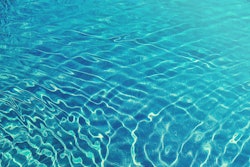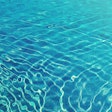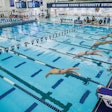![Quechee Club in Quechee, Vt. [Photos by Bruce T. Marten]](https://img.athleticbusiness.com/files/base/abmedia/all/image/2018/08/ab.OutdoorPool718_feat.png?auto=format%2Ccompress&q=70&w=400)
One of the three outdoor pool options presented to the Boulder City (Nev.) Parks and Recreation Commission earlier this year included a $27.3 million plan to build three bodies of water — including a competition pool and a recreation pool with extensive play features — that would anchor space for indoor racquetball courts and multiple fitness areas.
"The trend is to build competition and recreation pools on the same site," says Mike Gartland, a principal with St. Louis-based Counsilman-Hunsaker, the aquatic consulting firm helping to design the Boulder project. "It's been headed that way for the past five or six years, because that approach makes good use of available land."
The design that Boulder's Parks and Recreation Commission sent to the City Council for consideration was based on months of design discussions and comments from local residents.
"The more community input the better. Everyone needs to be heard. Everyone needs to feel like they have the opportunity to contribute to the future of their community," says Justin Caron, a principal and vice president at Aquatic Design Group, headquartered in Carlsbad, Calif. "I've seen more entities doing their due diligence on the front end now. So, instead of those discussions being part of the formal design process, they're done as part of a feasibility study or master plan study. That's when site selection happens. That's when community involvement happens."
Involvement in an outdoor pool project, whether in the public or private sector, often is a once-in-a-career opportunity. But with so many "cookie cutter" pools from the 1960s, '70s and '80s nearing or past their life expectancies, those opportunities could become more frequent over the next decade.
"We're still replacing a lot of those pools, and I think we're going to see that for another 10 years," Gartland says. "One of the most common pitfalls is not understanding the options that are out there, the different varieties of outdoor recreation pools that are available. The pools we designed decades ago are what people grew up with, and a lot of those people still have that rectilinear, six-lane lap pool in mind when they talk about a community pool. They have to remember to think about so many other features that are available. That's our role: to help open their minds to different possibilities."
Regardless of whether your outdoor pool project is intended for recreational use, competitive use or both, it's critical to enter the design process with an understanding of the community's needs, a sense of realistic expectations and a willingness to admit what you don't know.
As Caron says, "We see some pretty sophisticated and savvy clients, and some who have no idea where to start."

Your first three steps
Just like planning for any other sports or recreation project, designing an outdoor pool requires facility stakeholders to follow a series of steps. Here are three big ones:
1. Determine the pool's program.
What you need to do around the pool depends on what you plan to do in the pool. How many pools do you want? Will there be a competition component? What about water exercise and therapy classes? Each of these categories requires different design elements — from water depths and temperatures to deck space.
For example, Gartland recommends that competition pools be oriented in a north-south direction to take into account sun and wind. For competition pools, restrooms and locker areas likely won't need to be located as close to the pool as they would in a recreational environment, where younger users and families will be accommodated.
While deck space for a competition pool must allow for plenty of room behind starting blocks and diving boards — as well as enough space for teams to congregate — recreational pools require even more space.
"A good rule of thumb on a recreation pool is to provide twice the amount of deck space as pool square footage," Gartland says.
That amount of space will help accommodate lounge seating, concessions areas and even cabanas, according to Caron. Deck materials matter, too. In hot climates where concrete can heat up to more than 110 degrees Fahrenheit, a heat-reducing finish can help keep sensitive bare feet cool.

2. What will surround the pool?
"You have to figure out what's going into the pool first," Caron says. "But almost as important are the adjacencies."
And the most important element of those adjacencies is (and always will be) shade, often in the form of stylish shade structures, but also trees. "Maintenance people typically don't like [trees near the pool], but sometimes that is an important aesthetic and they need to be a component that's included in that project," Caron says, adding that the amount of shade a project receives often changes to meet budget constraints. "The demand for shade is so great that you can never have enough. The majority of projects we work on don't get the original amount of shade we thought they were going to get."
Seating in competitive environments also is an important element that shouldn't be overlooked. Don't position bleachers to run directly parallel with the pool; otherwise, spectators will be looking into the sun, Gartland says. Seating capacity will largely be determined by the level of competition desired, but keep in mind that temporary bleachers can be brought in in, provided there's enough room on the deck and in adjacent spaces.
Other adjacencies depend on the pool operator's needs and location. Sand is a popular element, especially for municipalities incorporating playground equipment and college recreation centers offering volleyball.
3. Recognize the possibilities
So many design and programming options exist today that it's easy to create an outdoor pool project that stands out from others in neighboring communities. Consider a combination of variable depths, creative configurations, programming ideas and potential partnerships that could lead to distinct design opportunities.
"Understand the whole spectrum of aquatics and don't have blinders on," Caron suggests. "The beautiful thing about aquatics is that everyone can use a pool — regardless of capability, age, income, or if you're obese or injured. Pools can truly be enjoyed by people from every background and walk of life."
Indeed, outdoor pools offer recreational and athletic opportunities that no other facility can come close to matching. Similarly, they present design challenges unlike those encountered in other projects. But because aquatics has the potential to impact so many user groups, it's important that planners of a new pool work with a design team to determine how to incorporate a community's shifting demographics into the facility's long-term success.
"The industry is going to continue to come up with new ways to accommodate user groups — different temperatures of the pool water, different depths and different accessibility methods," Gartland says. "And when those three variables change, I think you're going to see the evolution continue."
This article originally appeared in the July|August 2018 issue of Athletic Business with the title "What to consider when designing an outdoor pool." Athletic Business is a free magazine for professionals in the athletic, fitness and recreation industry. Click here to subscribe.





































